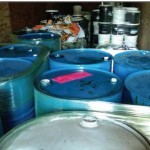WASHINGTON – Wal-Mart Stores Inc. pleaded guilty today in cases filed by federal prosecutors in Los Angeles and San Francisco to six counts of violating the Clean Water Act by illegally handling and disposing of hazardous materials at its retail stores across the United States. The Bentonville, Ark.-based company also pleaded guilty today in Kansas City, Mo., to violating the Federal Insecticide, Fungicide and Rodenticide Act (FIFRA) by failing to properly handle pesticides that had been returned by customers at its stores across the country.
As a result of the three criminal cases brought by the Justice Department, as well as a related civil case filed by the U.S. Environmental Protection Agency (EPA), Wal-Mart will pay approximately $81.6 million for its unlawful conduct. Coupled with previous actions brought by the states of California and Missouri for the same conduct, Wal-Mart will pay a combined total of more than $110 million to resolve cases alleging violations of federal and state environmental laws.
According to documents filed in U.S. District Court in San Francisco, from a date unknown until January 2006, Wal-Mart did not have a program in place and failed to train its employees on proper hazardous waste management and disposal practices at the store level. As a result, hazardous wastes were either discarded improperly at the store level – including being put into municipal trash bins or, if a liquid, poured into the local sewer system – or they were improperly transported without proper safety documentation to one of six product return centers located throughout the United States.
“By improperly handling hazardous waste, pesticides and other materials in violation of federal laws, Wal-Mart put the public and the environment at risk and gained an unfair economic advantage over other companies,” said Ignacia S. Moreno, Assistant Attorney General for the Justice Department’s Environment and Natural Resources Division. “Today, Wal-Mart acknowledged responsibility for violations of federal laws and will pay significant fines and penalties, which will, in part, fund important environmental projects in the communities impacted by the violations and help prevent future harm to the environment.”
“Federal laws that address the proper handling, storage and disposal of hazardous wastes exist to safeguard our environment and protect the public from harm,” said André Birotte Jr., the U.S. Attorney for the Central District of California. “Retailers like Wal-Mart that generate hazardous waste have a duty to legally and safely dispose of that hazardous waste, and dumping it down the sink was neither legal nor safe. The case against Wal-Mart is designed to ensure compliance with our nation’s environmental laws now and in the future.”
“As one of the largest retailers in the United States, Wal-Mart is responsible not only for the stock on its shelves, but also for the significant amount of hazardous materials that result from damaged products returned by customers,” said Melinda Haag, U.S. Attorney for the Northern District of California. “The crimes in these cases stem from Wal-Mart’s failure to comply with the regulations designed to ensure the proper handling, storage, and disposal of those hazardous materials and waste. With its guilty plea today, Wal-Mart is in a position to be an industry leader by ensuring that not only Wal-Mart, but all retail stores properly handle their waste.”
“This tough financial penalty holds Wal-Mart accountable for its reckless and illegal business practices that threatened both the public and the environment,” said Tammy Dickinson, U.S. Attorney for the Western District of Missouri. “Truckloads of hazardous products, including more than 2 million pounds of pesticides, were improperly handled under Wal-Mart’s contract. Today’s criminal fine should send a message to companies of all sizes that they will be held accountable to follow federal environmental laws. Additionally, Wal-Mart’s community service payment will fund important environmental projects in Missouri to help prevent such abuses in the future.”
“The FBI holds all companies, regardless of size, to the same standards,” said FBI Special Agent in Charge David J. Johnson of the San Francisco Field Office. “We will continue to work closely with our law enforcement partners to ensure there is a level playing field for all businesses and that everyone follows the rules.”
“Today Wal-Mart is taking responsibility for violating laws that protect people from hazardous wastes and chemicals,” said Cynthia Giles, assistant administrator for EPA’s Office of Enforcement and Compliance Assurance. “Walmart is committing to safe handling of hazardous wastes at all of its facilities nationwide, and action that will benefit communities across the country.”
Wal-Mart owns more than 4,000 stores nationwide that sell thousands of products which are flammable, corrosive, reactive, toxic or otherwise hazardous under federal law. The products that contain hazardous materials include pesticides, solvents, detergents, paints, aerosols and cleaners. Once discarded, these products are considered hazardous waste under federal law.
Wal-Mart pleaded guilty this morning in San Francisco to six misdemeanor counts of negligently violating the Clean Water Act. The six criminal charges were filed by the U.S. Attorney’s Office in Los Angeles and San Francisco (each office filed three charges), and the two cases were consolidated in the Northern District of California, where the guilty pleas were formally entered before U.S. Magistrate Judge Joseph C. Spero. As part of a plea agreement filed in California, Wal-Mart was sentenced to pay a $40 million criminal fine and an additional $20 million that will fund various community service projects, including opening a $6 million Retail Compliance Assistance Center that will help retail stores across the nation learn how to properly handle hazardous waste.
In the third criminal case resolved today, Wal-Mart pleaded guilty in the Western District of Missouri to violating FIFRA. According to a plea agreement filed in Kansas City, beginning in 2006, Wal-Mart began sending certain damaged household products, including regulated solid and liquid pesticides, from its six return centers to Greenleaf LLC, a recycling facility located in Neosho, Mo., where the products were processed for reuse and resale. Because Wal-Mart employees failed to provide adequate oversight of the pesticides sent to Greenleaf, regulated pesticides were mixed together and offered for sale to customers without the required registration, ingredients, or use information, which constitutes a violation of FIFRA. Between July 2006 and February 2008, Wal-Mart trucked more than 2 million pounds of regulated pesticides and additional household products from its various return centers to Greenleaf. In November 2008, Greenleaf was also convicted of a FIFRA violation and paid a criminal penalty of $200,000 in 2009.
Pursuant to the plea agreement filed in Missouri and accepted today by U.S. District Judge John T. Maughmer, Wal-Mart agreed to pay a criminal fine of $11 million and to pay another $3 million to the Missouri Department of Natural Resources, which will go to that agency’s Hazardous Waste Program and will be used to fund further inspections and education on pesticide regulations for regulators, the regulated community and the public. In addition, Wal-Mart has already spent more than $3.4 million to properly remove and dispose of all hazardous material from Greenleaf’s facility.
In conjunction with today’s guilty pleas in the three criminal cases, Wal-Mart has agreed to pay a $7.628 million civil penalty that will resolve civil violations of FIFRA and Resource Conservation and Recovery Act (RCRA). In addition to the civil penalties, Wal-Mart is required to implement a comprehensive, nationwide environmental compliance agreement to manage hazardous waste generated at its stores. The agreement includes requirements to ensure adequate environmental personnel and training at all levels of the company, proper identification and management of hazardous wastes, and the development and implementation of Environmental Management Systems at its stores and return centers. Compliance with this agreement is a condition of probation imposed in the criminal cases.
The criminal cases announced today are a result of investigations conducted by the FBI and the EPA, which received substantial assistance from the California Department of Substance and Toxics Control, and the Missouri Department of Natural Resources.
In Missouri, the case was prosecuted by Deputy U.S. Attorney Gene Porter and ENRD Senior Trial Attorney Jennifer Whitfield of the Environmental Crimes Section of the Environment and Natural Resources Division. In California, the cases were prosecuted in Los Angeles by Assistant U.S. Attorney Joseph O. Johns and in San Francisco by Assistant U.S. Attorney Stacey Geis.
Release Date: 05/28/2013
Contact Information: Dale Kemery (News media only) kemery.dale@epa.gov 202-564-7839 202-564-4355
More information about the case: URL http://www.epa.gov/enforcement/waste/cases/walmart.html




